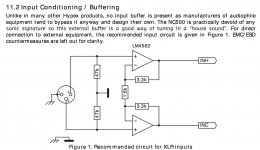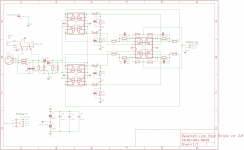Speculation is not the right term; I do not aim to "talk" NC400 into distortion territory which would be ridiculous as it sets very high standards.
Up to some 3 W the THD is dominated by noise; I get it is THD+N and THD alone might be about non existant.
The THD+N graph of NC400 and about every class AB amplifier reminded me of Nelson Pass' comparison of class A and class B:
View attachment 532227
Here we see distortion profiles of class A (red curve) and class B (blue curve) without N; I had the class B graph in mind which show rising distortion at low level (crossover artifacts), but realize that THD and THD+N graphs are not comparable.
With N involved the class A graph will look much more like class AB and D graphs.
Indeed. And there's class B and then there's class B. Doug Self's optimal based class B is a special animal.
Jan
Indeed. And there's class B and then there's class B. Doug Self's optimal based class B is a special animal.
Jan
..and even there we have to talk "shades" of A, AB, and B. Not that I care if someone calls it class __ or class __, as long as it does it's job!
I can't really see a case where lowering the load impedance of an amplifier is beneficial (within the realm of a speaker strapped to the end of it at least, something else might be said for impedance matching networks, etc); at best the amplifier is sufficiently load invariant that it just chugs along (see: Hypex). This is especially exacerbated in underbiased class B output stages (AB, or whatever classification you wish to call it), as crossover distortion only gets worse with loading.
In regards to the discrete Opamps for the Hypex, the best reason I could see needing them in this application is that you can dedicate a lot more silicon to your differential pair transistors and push noise down (done right, that is) than can be readily achieved in a integrated chip. The output of the opamp is pretty lightly loaded.
He was very forthcoming with some additional values to the Input board. He has a broadcast company use them in the same application.
"Hypex's implimentation of there balanced buffer circuit has 4.7M resistor to ground on the input side of the opamp and there is no high frequency rolloff in the feedback path. This resistors Johnson noise becomes the dominant noise source and is slightly audible here in our lab setup using the NC500 buffer board. As our opamps are extremely wideband and fast, we have found that making the 4.7M a 10k to 47K will drop the noise floor about 36-30dB. We and several of our customers have contacted Hypex regarding this and they may of changed this input circuit by now. So just a technical heads up"
The other bit I don't get about this comment is that the 47K resistors aren't in the signal path. It's the noise of the 3.3K and 1.5K resistors that matter. And it is here that the discussion in Self's Small Signal Audio Design (2nd Ed.) may prove very useful (particularly the discussion from pg 527 onward). The challenge is to be able to lower the resistor values while still presenting a good input impedance to the source. Self describes the use of buffering the input with voltage-followers and doing so with multiple buffers to take advantage of RMS addition of uncorrelated noise sources. I am deploying his advice in a balanced input circuit to feed a single-ended IPS/VAS of an existing and extremely good amplifier design by DIYAudio member "astx". I attach the circuit in this application. To my mind, this would be a far more fruitful endeavour than randomly swapping out the LM4562 for noisier discrete alternatives.
Attachments
Last edited:
Hi Tane0019
Did or do you have Monitor Audio PL speakers by any chance? Thought I had seen some comments from you on a foreign Forum, when I was researching all this stuff some time ago
Yap
MA PL200 + PLC150 for the LCR.
Left & Right driven by DIY NC400 Mono
Center is driven by DIY Class D Audio SDS258 (one channel only).
MA spks are generally slightly on the brighter side. Therefore pairing is key.
NC400 amp is slightly on the warm side (ie slightly bassy), therefore for it the combo is just right for me.
Not too bright at the top.
Mid is sweet.
Bass at times is too much, but of course my setup/room does have a 40-45 Hz modal resonance of about 3-6 dB.
NC400 amp is slightly on the warm side (ie slightly bassy), therefore for it the combo is just right for me.
Not too bright at the top.
Mid is sweet.
Bass at times is too much, but of course my setup/room does have a 40-45 Hz modal resonance of about 3-6 dB.
Thanks Mr Tan, I have also got PL200 ...I took some of your comments to heart when buying my PL200 last year
How do you find the treble with nCore amplifiers? I am still finding a brassy edge to them, a little bit shrill or metallic
If thats the case I would use the Sparkos op amps, the Bursons are brighter.
MA spks are generally slightly on the brighter side. Therefore pairing is key.
NC400 amp is slightly on the warm side (ie slightly bassy), therefore for it the combo is just right for me.
Not too bright at the top.
Mid is sweet.
Bass at times is too much, but of course my setup/room does have a 40-45 Hz modal resonance of about 3-6 dB.
If thats the case I would use the Sparkos op amps, the Bursons are brighter.
I can't see that Bruno Putzey would design any of his ncores with a less than perfectly flat frequency response!
Therefore I'd blame any differences purely on the amp/speaker/room/ear interaction and not a character of the amp itself.
That should apply to Nc400, nc500, nc1200. Isn't it just an audiophile fad/meme to "tune" amps with tweaks? No different to tuning with cables or spikes/supports but seemingly more rational just because of the technical mindset doing it this time (as opposed to the regular mystical mindset of the usual audiophile tweaker sticking crystals on top of electronics).
Neutral is neutral is it not?
That should apply to Nc400, nc500, nc1200.
....and to all other decent amplifiers, unless unable to drive the used loudspeaker properly.
Sorry guys, I take it all back - a minor correction to be made!
Both the NC1200 and NC400 are down 1db at 30kHz, 0.5db at 20kHz! (but otherwise completely flat elsewhere). I'd guess the nc500 to also be the same.
But they are all the exactly same in terms of frequency response.
Both the NC1200 and NC400 are down 1db at 30kHz, 0.5db at 20kHz! (but otherwise completely flat elsewhere). I'd guess the nc500 to also be the same.
But they are all the exactly same in terms of frequency response.
Last edited:
....and to all other decent amplifiers, unless unable to drive the used loudspeaker properly.
At least there might be more of an excuse in those cases due to feedback implementation.
Both the NC1200 and NC400 are down 1db at 30kHz, 0.5db at 20kHz! (but otherwise completely flat elsewhere).
And how many of us can still hear up to 20k?
I certainly don't agree - there is no ruler. Each set of measurements says it's own thing and it's up to you to find the appropriate measurement to find out about the thing you're interested in.
BUT if you're talking about changing the level of treble output (for example) to make something sound brighter or make it sound less bright, I would never blame an amp with a flat frequency response or even attribute such an amp to be "warm" in one instance and another with the exact same frequency response to be "bright" in another instance.
If those sound differences are real then it is not down to frequency response or it's frequency response character! It will be down to one's specific system. In which case one cannot characaterised the amp to have a "sound" only that it interacts in a certain way which will again be different, opposite in another system.
So, to then "tune" an amp's sound by changing input buffers for example to attempt to change the frequency response of the system is neither finding out what the problem is nor solving the problem.. it's kind of painting over the cracks. It could even be that those cracks are entirely down to the hearing response and preferences of the listener too.
There's nothing wrong with that tuning but lots wrong with the extrapolation of the results as any kind of universal truth to be applied to anything other than one's own system and hearing and room etc etc.
Personally I'd look to change speakers, move the speakers about a bit, mod the speakers to effect dispersion/edge diffraction etc or try to add some kind of room treatment (if domestically possible) and keep the electronics as neutral as possible..
BUT if you're talking about changing the level of treble output (for example) to make something sound brighter or make it sound less bright, I would never blame an amp with a flat frequency response or even attribute such an amp to be "warm" in one instance and another with the exact same frequency response to be "bright" in another instance.
If those sound differences are real then it is not down to frequency response or it's frequency response character! It will be down to one's specific system. In which case one cannot characaterised the amp to have a "sound" only that it interacts in a certain way which will again be different, opposite in another system.
So, to then "tune" an amp's sound by changing input buffers for example to attempt to change the frequency response of the system is neither finding out what the problem is nor solving the problem.. it's kind of painting over the cracks. It could even be that those cracks are entirely down to the hearing response and preferences of the listener too.
There's nothing wrong with that tuning but lots wrong with the extrapolation of the results as any kind of universal truth to be applied to anything other than one's own system and hearing and room etc etc.
Personally I'd look to change speakers, move the speakers about a bit, mod the speakers to effect dispersion/edge diffraction etc or try to add some kind of room treatment (if domestically possible) and keep the electronics as neutral as possible..
Last edited:
Sorry guys, I take it all back - a minor correction to be made!
Both the NC1200 and NC400 are down 1db at 30kHz, 0.5db at 20kHz! (but otherwise completely flat elsewhere). I'd guess the nc500 to also be the same.
But they are all the exactly same in terms of frequency response.
What equipment did you use to measure that? Just curious.
Jan
I can only hear up to 15-16Khz with sine wave EQ tests hahaha ...but treble still annoys me , go figure 8-/
Treble starts much lower than 15k, and coloration in the treble might also be caused by distortion.
What equipment did you use to measure that? Just curious.
Both the NC1200 and NC400 are down 1db at 30kHz, 0.5db at 20kHz! (but otherwise completely flat elsewhere).
Those numbers sound like they are taken from the graphs in the hypex data sheets.
- Status
- Not open for further replies.
- Home
- Amplifiers
- Class D
- Hypex Ncore

